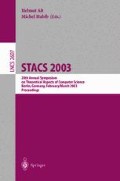Abstract
We show that every regular language L has either constant, logarithmic or linear two-party communication complexity (in a worstcase partition sense). We prove a similar trichotomy for simultaneous communication complexity and a “quadrichotomy” for probabilistic communication complexity.
Research supported in part by NSERC and FCAR grants.
Access this chapter
Tax calculation will be finalised at checkout
Purchases are for personal use only
Preview
Unable to display preview. Download preview PDF.
References
L. Babai, P. Frankl, and J. Simon. Complexity classes in communication complexity theory. In Proc. 27th IEEE FOCS, pages 337–347, 1986.
D. A. Barrington. Bounded-width polynomial-size branching programs recognize exactly those languages in NC1. J. Comput. Syst. Sci., 38(1):150–164, Feb. 1989.
D. A. M. Barrington and D. Thérien. Finite monoids and the fine structure of NC1. Journal of the ACM, 35(4):941–952, Oct. 1988.
C. Damm,, M. K. C. Meinel, and S. Waack. On relations between counting communication complexity classes. To appear in Journal of Computer and Systems Sciences. Currently available e.g. from http://www.num.math.uni-goettingen.de/damm/ and preliminary version in proceedings of STACS’92.
E. Kushilevitz and N. Nisan. Communication Complexity. Cambridge University Press, 1997.
J.-E. Pin. Varieties of formal languages. North Oxford Academic Publishers Ltd, London, 1986.
P. Pudlák. An application of Hindman’s theorem to a problem on communication complexity. Draft, 2002.
J.-F. Raymond, P. Tesson, and D. Thérien. An algebraic approach to communication complexity. Lecture Notes in Computer Science (ICALP’98), 1443:29–40, 1998.
M. Szegedy. Functions with bounded symmetric communication complexity, programs over commutative monoids, and ACC. J. Comput. Syst. Sci., 47(3):405–423, 1993.
Author information
Authors and Affiliations
Editor information
Editors and Affiliations
Rights and permissions
Copyright information
© 2003 Springer-Verlag Berlin Heidelberg
About this paper
Cite this paper
Tesson, P., Thérien, D. (2003). Complete Classifications for the Communication Complexity of Regular Languages. In: Alt, H., Habib, M. (eds) STACS 2003. STACS 2003. Lecture Notes in Computer Science, vol 2607. Springer, Berlin, Heidelberg. https://doi.org/10.1007/3-540-36494-3_7
Download citation
DOI: https://doi.org/10.1007/3-540-36494-3_7
Published:
Publisher Name: Springer, Berlin, Heidelberg
Print ISBN: 978-3-540-00623-7
Online ISBN: 978-3-540-36494-8
eBook Packages: Springer Book Archive

